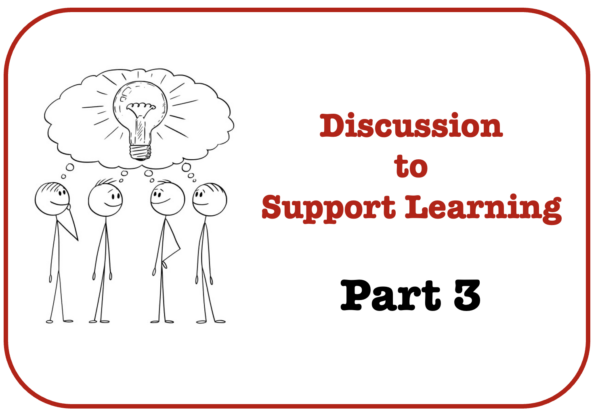Discussion to Support Learning, Part 3

This is the third of a three-part series of posts focused on using discussion to support learning. Part 1 introduced how discussion supports learning, especially discussion based on text. Part 1 also reviewed the research supporting classroom discussion, described formats, and offered instructional suggestions. Part 2 provided suggestions for planning discussions, including preparing questions that are used to begin and sustain a discussion. Part 2 also offered suggestions for using discussion norms that enable all students to participate in discussions.
Academically Productive Talk
Simply getting students to talk out loud or talk to one another does not necessarily lead to learning. Effective, academic talk and classroom discussions should be productive, meaning students share their own thinking and reasoning and listen with a purpose to other people’s thinking. Productive discussion is sometimes called dialogic teaching, dialogic pedagogy, argumentation, accountable talk, and respectful discussion. It is more than just answering questions by teachers that have a single answer.
High quality, productive discussions require critical thinking, are structured, are deliberative and reciprocal, and include academic language and vocabulary. Effective discussions are prepared in advance and are purposely led by the teacher. They include sustained talk with students defending their statements by referring to text or citing valid information. The classroom features of academically productive talk include students explaining what they are thinking, relating their own ideas or experiences to the focal issue, reacting to what other students have said, and students reasoning together. (Michaels et al., 2013; Strategic Education Research Partnership, A & B; Resnick et al., 2015; Wilkinson & Nelson, 2020)
Resnick and colleagues (2015, p. 6) explain high-quality, productive talk as follows:
“This kind of talk begins with students thinking out loud about a domain concept: noticing something about a problem, puzzling through a surprising finding, or articulating, explaining, and reflecting upon their own reasoning. Students do not simply report facts they already know for the teacher to evaluate. Instead, with teacher guidance, they make public their half-formed ideas, questions, and nascent explanations. Other students take up their classmates’ statements: challenging or clarifying a claim or an alternate explanation. This form of talk is orchestrated by a teacher. It may be conducted in whole groups, smaller collaborative groups, or with pairs of students. The key component is the learning power generated by two or more minds working on the same problem together.”
Accountable Talk
Accountable Talk is a framework for supporting academically productive talk developed by researchers at the University of Pittsburgh, Institute for Learning (O’Connor, 2012; Michels et al., 2013). It can be used in a variety of ways to support discussion in the classroom. With this approach to discussion, students explain their thinking with evidence and listen and respond constructively to others’ ideas. Guided by teachers who provide scaffolds such as discussion sentence starters, Accountable Talk promotes learning and can be used for discussions about text. (Michaels et al., 2013; Michaels & O’Connor, 2012).
For this kind of talk to promote learning, it must be accountable on three levels (O’Connor, 2012; Michaels et al, 2013; Resnick, 2018):
Accountable to Accurate Knowledge: Students are responsible for properly understanding and using facts and information. They should:
- Explain how they arrived at their answer or conclusion
- Be as specific and accurate as possible when sharing information
- Avoid saying just anything that comes to mind
- Point out the relationships among previous statements and knowledge
Accountable to Rigorous Thinking and Reasoning: Students are responsible for reasoning and thinking through challenges together. They should:
- Build arguments by linking claims and supporting evidence in logical ways
- Incorporate knowledge from multiple sources to form their ideas
- Defend their reasoning against a different point of view
- Ask others to explain their claims and supporting evidence
Accountable to the Learning Community: Students show respect for the ideas and feelings of others. They should:
- Recognize that everyone has the right to contribute to a discussion
- Carefully listen and pay attention to what others say
- Paraphrase or summarize what others say and seek clarification
- Acknowledge the value of others’ statements and add on to others’ ideas
- Respectfully disagree with others
Facilitating Discussion
Facilitating a high-quality discussion is not the same as lecturing or more traditional forms of classroom discourse where the teacher poses questions that students answer. It is important to remember that rather than being the one who does most of the talking, the teacher as facilitator is there to guide a discussion where the students do most of the talking.
Teachers should emphasize that all participants have something to contribute to a discussion. They can do this by asking questions that prompt students to consider the comments of others, revoicing students’ ideas to give others the opportunity to reflect on and refine what was said, and by acknowledging that sometimes students may share faulty or incomplete understandings and comments. (Resnick et al., 2018)
One way to provide a more structured discussion during which all students have an opportunity to talk without being interrupted is to use a talking object. This is an item that can be passed easily from one student to another, such as a ball. The student holding the talking object is the only person speaking while others are actively listening. When the student is done speaking, they pass it along to another student who indicates they would like to speak.
Suggestions for Teachers
Teachers should consider the following suggestions for supporting discussion (adapted from Cashin, 2011):
- Allow for wait time, pauses, and silences. Students need time to think, prepare what they want to say, and process what others are saying.
- Make sure everyone listens to whomever is speaking.
- Encourage and recognize students’ contributions.
- Observe who is participating and provide opportunities for those who are not to contribute to the discussion. This includes controlling excessive talkers.
- Be sensitive to students’ feelings and emotional reactions, especially students who may be fearful of being critiqued.
- Deal with conflicts; help clarify disagreements and misunderstandings.
- Provide summaries periodically during the discussion and at the end.
- Help students reflect and think about what took place during the discussion, including what worked well and what might be done differently.
Suggestions for Students
Teachers should make sure students know the following about high-quality discussions (adapted from Cashin, 2011):
- Students must come prepared, having read and thought about the text ahead of time. Teachers might ask students to complete some type of writing task prior to the start of the discussion, such as annotating the text, writing a list of key points from the text, or answering a few basic questions.
- Students must be active participants in discussions, ready to explain their ideas clearly. This includes being a good listener by maintaining eye contact and using body language that lets the speaker know the student is listening and participating in revoicing of others’ statements.
- Students’ focus during the discussion should be on more complex thinking rather than recalling facts. This includes supporting what they have to say with evidence from the text.
Teacher and Student “Talk Moves”
Talk Moves are a set of strategic moves developed as part of the Accountable Talk framework that help support productive, accountable discussions. They include actions teachers take to facilitate and support discussions, and statements students make that are driven by discussion sentence starters. (O’Connor, 2012; Michaels & O-Connor, 2012; Michaels et al., 2013)
Michaels and O’Connor (2012, p. 10) describe Talk Moves as follows:
“Research over the past 20 years and documentation of teachers who facilitate productive discussions has led to the identification of a small number of general talk moves that are remarkably helpful tools for making discussions work. These talk moves can be used at any point in a discussion, in any subject domain, and are especially helpful in classroom settings. They strategically set students up to think, reason, and collaborate in academically productive ways.”
Teacher Discussion Moves
The following eight strategies summarize the tools teachers use to support productive discussions (adapted from: Michaels & O’Connor, 2012; Michaels et al., 2013; Resnick, Asterhan, Clarke, 2018):
Wait Time, Time to Think: The teacher allows quiet thinking time for students to develop responses. Wait time should be given not only after presenting a question, but also after calling on a student. Waiting for a student response may feel uncomfortable to some, but with practice it becomes natural. Students who are normally quiet can provide especially insightful responses if the teacher uses wait time. This move allows more students to participate and builds confidence in those less accustomed to speaking out.
Revoicing: The teacher repeats a part or all of a student’s utterance and asks the student to verify whether the interpretation is correct. The student’s role is to verify. This helps students realize they must be clear when they contribute. This can be especially helpful to teachers when they do not understand what was said.
- Examples: I infer ____, is that right? Is that correct?
Add On, Say More: The teacher asks students to elaborate or add on to what they said, or the teacher asks another student to add on or say more about a classmate’s contribution. Students enjoy having a platform from which to start their follow-up comment.
- Examples: Can you say more about that? What do you mean by that? Can anyone add onto what ____ said?
Repeat, Rephrase: The teacher asks a student to restate a contribution of a classmate, either verbatim or paraphrased. Repeating, especially when reformulated in a student’s own words, requires another layer of thinking. This move changes the level at which students listen because the expectation is that students may be called on to repeat.
- Examples: Are you saying ____? Can someone rephrase that? Did everyone hear that?
Example, Counterexample: The teacher asks a student to provide an example or counter example of a classmate’s contribution. This move serves as an effective check for understanding.
- Examples: Can you give an example of that? Can someone offer an example that does not support ____?
Agree, Disagree: The teacher asks students whether they agree or disagree with a comment, then also asks why. It is important to add the why when using this move. This is an effective move to control and encourage close attention to classmates’ contributions.
- Examples: Who agrees or disagrees, and why? Does anyone have a different view? Does anyone want to respond to that idea?
Press for Reasoning: The teacher asks students to explain how or why they came to their position or reached a certain solution. This move emphasizes the importance of presenting evidence to support a claim, including citing text evidence.
- Examples: Why do you think that? Can you explain your reasoning to us? What is your evidence? Is there anything in the text that made you think that?
Recapping: The teacher summarizes the ideas that evolved during the discussion. Recapping supports a shared understanding of the topic under discussion.
Talk Moves: Student Sentence Starters
The following sentence starters organized into nine categories can be used by students to promote productive, accountable talk and scaffold students’ responses and contributions during a discussion (Michaels, O’Connor & Resnick, 2008; Michaels & O’Connor, 2012; Michaels et al., 2013).
Teachers should introduce students to the categories and sentence starters based on the grade and skill-level of students, beginning with just one or two for younger students. It is helpful to make a list of the sentence starters available on a classroom chart or on laminated cards that students can keep at their desks.
Expressing an Opinion
- I think/believe ____.
- In my opinion ____.
- It seems to me that ____.
Expressing Confusion
- I don’t’ understand____.
- I am confused about ____.
- That is confusing because ____.
Agreeing
- I agree with what ____ is saying because ____.
- I like what ____ said because ____.
- My idea is similar to/related to ____’s idea that ____.
- I agree with ____, but on the other hand ____.
Disagreeing
- I disagree with ____ because ____.
- I’m not sure I agree with what ____ said because ____.
- I can see that ____; however, I disagree with ____.
- Couldn’t it also be that ____?
- I see why ____ might say that, but ____.
- While I think ____ had a point that ____, I disagree with the part ____.
Paraphrasing What Someone Said
- In other words, you think ____.
- What I heard you say is ____.
Seeking Clarification
- Could you please repeat that for me?
- Could you explain a bit more?
- What did you mean when you said ____?
- I’m not sure I understood you when you said _____. Could you say more about that?
- What led you to that conclusion?
- What is your evidence?
Making a Connection
- What ____ said reminded me of ____.
- This makes me think _____.
- This reminds me of ____
- This is like ____ but different because ____.
Adding On/Extention
- I’d like to say more about what ____ said about ____.
- I’d like to add ____.
- I want to know more about ____.
Making a Prediction
- I think that ____ will happen because ____.
- I wonder if ____.
- Based on ____ I infer that ___.
Summary
Discussion supports learning in all subjects because it helps students think deeply and process information instead of just receiving it. In particular, discussion about text students have read supports comprehension and critical thinking. Research demonstrates that using high-quality discussion that is planned ahead of time has positive benefits for learning across different subjects. Discussion formats include teacher-led whole classroom, small-group student-led, and partner talk. Discussion will be more effective if teachers carefully prepare ahead of time, including generating questions including an open-ended initiation question, follow-up questions that keep the discussion going, and after questions that debrief the discussion. Teaching student collaboration skills is helpful, including sharing norms for engagement in discussions. Academically productive talk emphasizes students sharing their reasoning and thinking with peers, and questioning and contributing to others’ ideas. It is structured talk that requires participation by all students.
Part 3 References
- Cashin, W.E. (2011). Effective classroom discussions. The IDEA Center, Kansas State University.
- Michaels, S. & O’Connor, C. (2012). Talk science primer. Talk Science Project (TERC).
- Michaels, S., O’Connor, C., Hall, M.W., & Resnick, L.B. (2013). Accountable talk source-book: For classroom conversation that works. Pittsburgh, PA; University of Pittsburg Institute for Learning.
- Michaels, S., O’Connor, C., & Resnick, L. B. (2008). Deliberative discourse idealized and realized: Accountable talk in the classroom and in civic life. Studies in Philosophy and Education, 27(4), 283–297.
- O’Connor, C. (2012). Academically Productive Talk: Discussion within Word Generation. PowerPoint delivered August 15, 2012, Baltimore Summer Institute.
- Resnick, L. B. C, Asterhan, C. S. C., & Clarke, S. N. (2015). Introduction: Talk, Learning, and Teaching. In: L. B. Resnick, C. S. C. Asterhan & S. N. Clarke (Eds), Socializing Intelligence through academic talk and dialogue (pp. 1-12). Washington, DC: AERA.
- Resnick, L.B., Clarke, S., & Asterhan, C.S.C. (2018). Accountable talk: Instructional dialogue that builds the mind. Educational Practices, 29 (7).
- Strategic Education Partnership (A) (nd).. About academically productive talk. SERP Institute.
- Strategic Education Partnership (B) (nd). What do we mean by academically productive talk? SERP Institute.
- Wilkinson, A.G. & Nelson, K. (2020). Role of discussion in reading comprehension. In Hattie, J. & Amderman. E.M. (Eds.). Visible learning guide to student achievement: Schools edition. New York: Routledge.

 Joan Sedita is the founder of Keys to Literacy and author of the Keys to Literacy professional development programs. She is an experienced educator, nationally recognized speaker and teacher trainer. She has worked for over 35 years in the literacy education field and has presented to thousands of teachers and related professionals at schools, colleges, clinics, and professional conferences.
Joan Sedita is the founder of Keys to Literacy and author of the Keys to Literacy professional development programs. She is an experienced educator, nationally recognized speaker and teacher trainer. She has worked for over 35 years in the literacy education field and has presented to thousands of teachers and related professionals at schools, colleges, clinics, and professional conferences.
I love the idea of Talk Moves, for me I know I do struggle with giving the non-vocal students enough time to process and work through what we are talking about. This is something I have been trying to do more of. I know I would likely have more participation if I gave more time for my students verses me just giving the answer or making it an individual assignment due to lack of participation. These steps are very clear and offers ways to help use lead student questions such as paraphrasing, connections and predicting.